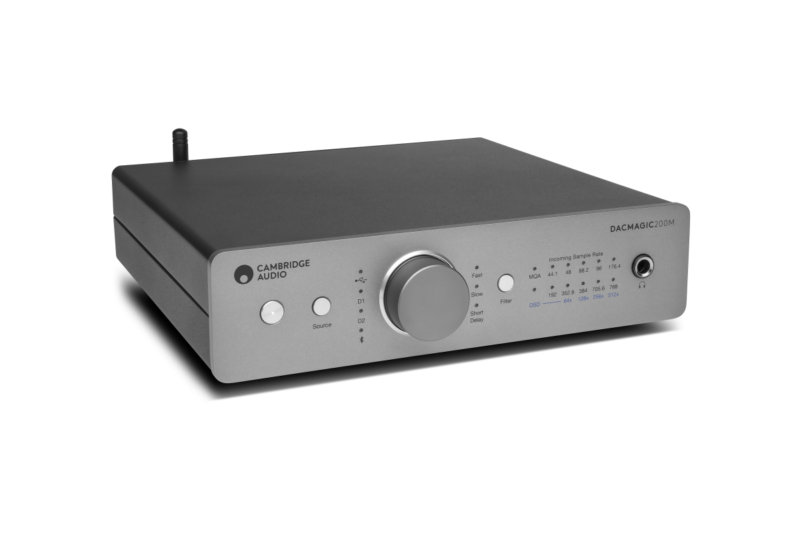Cambridge Audio Headphone Amp: Summary
Cambridge Audio’s DacMagic DACs have long provided solid functionality and impressive performance for the money. Their latest DacMagic product, the DacMagic 200M, is their most admirable effort yet.
The 200M supports the highest bit rates ever decoded in a DacMagic DAC (32-bit/768kHz), handles DSD and MQA, plus has built-in aptX Bluetooth (previous models needed an adapter). There’s also a powerful Class A/B headphone amp that will drive just about any headphones out there.
The sound is super detailed and natural, with an amazing amount of depth for the price.
At $499, this Cambridge Audio Headphone Amp and DAC is an amazing buy; if you’re looking to take your system’s sound to the next level, then you need to check it out!
Read on for more details regarding the DacMagic 200M!
Disclaimer: The DacMagic 200M was sent to us by the manufacturer in exchange for an honest, unbiased review. The DAC will be returned once our evaluation is complete.
Cambridge Audio Headphone Amp: Build
The DacMagic 200M has a similar design to the previous DacMagic DACs, basically a steel box with a thick aluminum faceplate. It’s a combination Cambridge Audio has leaned on since I purchased their integrated back in the early 2000s, and it still looks good.
On the front, you have nice chrome metal buttons for power, digital filters, digital source selection (at least they look like metal), and a large digital volume knob in the middle. There’s also a ¼” headphone jack for the Class A/B headphone amplifier.
The digital source select button and digital volume knob mean that if you have only digital sources, you can use this DAC as a digital “preamp.” However, keep in mind there is no remote control, so you will need to get up to control the volume. (unless you can adjust the volume at the source.)
The buttons give good feedback, but the volume knob was a little hard to turn, at least on my unit. A marker to let you know where you are in the volume range would be nice as well.
However, both issues amount to nitpicking because the knob works as it’s supposed to, providing a nice even increase in gain across the range.
The DacMagic 200M, like its predecessors, doesn’t have a display screen; all indication is provided via a bank of lights on the front panel. While a screen would be nice, the lack of one keeps the price down and removes the potential of unwanted noise in the signal.

On the back of the unit, you have both RCA unbalanced and XLR Balanced outputs, along with two digital inputs (each with coax/optical in), plus a USB input for connection to a laptop.
You also have a Bluetooth antenna for wireless connection (aptX compatible) and a ground/lift switch if you have USB ground loop issues. This is a nice feature to have, as it may help eliminate unwanted hum in your speakers. Of course, there’s also a plug for the external power supply.
The DacMagic 200M uses twin ESS Sabre ES9028Q2M 32-bit digital-to-analog converters in a dual-mono configuration. That’s one per channel, which aids in stereo separation, resolution, and depth. As stated earlier, this chip handles a wide range of high-resolution sample rates and file types, which vary depending on the connection used:
- Optical: up to 24-bit/96kHz PCM; DSD over PCM supported
- Coaxial: up to 24-bit/192kHz; DSD over PCM supported
- USB: up to 32-bit/768kHz; Native DSD up to 24.576MHz (DSD 512)
This DAC also fully decodes MQA, which means you can hear all MQA streams or files in the best possible quality. The lights on the front panel confirm the quality of all sources, including MQA.

When the MQA indicator is Green, it signifies a fully decoded standard MQA signal. Blue signifies MQA Studio, which means the file has “provenance” (you hear exactly what was recorded in the studio).
Magenta means the DAC is working as a render, playing an MQA file partially decoded by software such as the Tidal desktop app.
Three digital filters (fast, slow, short delay) are also available, which allow you to tweak the sound signature of the DAC. I liked the Short Delay filter as it seemed like the most expansive of the three, making the sound a little more open. From what I can see, the DAC also defaults to this filter when listening to MQA.
Listening to the Cambridge Audio DacMagic 200M
With its compact size, the DacMagic is equally at home on the desktop as it is in a hi-fi system, so I tested it in both places.
First, I used it as a DAC/Headphone amp on my desk, connecting it to my HP Envy X360 laptop via USB (Cambridge Audio USB Driver required). I plugged in a pair of Mr. Speakers (now Dan Clark Audio) ÆON Flow Closed headphones and played various tracks from the Audiophile 101 MQA Playlist. on Tidal.
The DacMagic’s headphone amplifier drove these notoriously hard-to-drive headphones to levels I had no business listening to, with plenty of headroom to spare. As I alluded to earlier, it has enough muscle for any headphones out there.
After the power, the next thing I noticed was how quiet it was. All you heard was music. The background was extremely clean, and you could hear “into” the recording in a way only possible with a highly transparent amp and DAC.
When playing “Draw Your Swords” by Angus Stone, the DacMagic 200M had a rich, emotive sound with amazing separation. Strings and vocals were fully fleshed out, which reflected the overall smoothness of the midrange.
It was also beautiful to hear the echo of the recording space reverberating all around the vocalist; it’s things like that which bring realism to the performance.
It’s not super analytical like other DACs that beat you over the head with detail. Instead, it provides a natural layering and resolution that’s very musical.
The other thing I liked about the DacMagic 200M and its headphone amp was how well it presented bass. The bass was extremely deep and articulate, giving the performance nice weight. It really made my AEON Flow Headphones sing.
With its crisp delivery and excellent tonal balance, this DAC also does a great job in a hi-fi rig.
I hooked it up to the same computer in my listening room, but this time I ran Roon through the DAC instead of the Tidal Desktop app. I connected the DacMagic 200M RCA output to the RCA input on my Cayin MT-12 Tube Amp, connected to a pair of Triangle Genese Trio Bookshelf speakers.
The DacMagic 200M is Roon Ready, and as such, it was quickly recognized by the software. Via Roon, I played the same TIDAL playlist I used to test the headphone amp section.
As much as I liked this DAC on the desktop, I liked it even more in the hi-fi setup. The layering and detail I heard through the headphones had more room to develop as it entered the room from the speakers.

The Cambridge Audio DAC enhanced the warmth and soundstage of the Cayin/Triangle combo. The imaging was remarkable as well, both in the center and edges of the stage. Each element of the mix was separated beautifully, which is amazing for such a reasonably priced device.
Listening to the same song from earlier, the male vocal was so vivid without any coloration, and the performance was airier. The background singers were off to the left in the rear, and the reverberations I heard over the headphones actually recreated the recording space in my listening room.
I never heard this setup sound so tight and cohesive. There was none of the edginess you expect to hear from an affordable DAC, plus the transparency of the performance was stunning. The way it helped tighten up and deepen the low end was also remarkable.
Lastly, I checked out the Bluetooth wireless connection, and using the aptX signal from my LG V60 smartphone it was really good! While some of the trailing edge details were lost, much of it was retained, and I really had to listen closely to hear the difference between wired and wireless. The wireless connection was great, and I would have no problem using it for casual listening sessions.
Now, can you get more depth and separation by spending more money? The answer is yes. But I think many audiophiles with systems in the 2-5k range could benefit from the sonic improvement of this standalone DAC.
The other things you will get by spending more would be a display screen that would provide more information and a remote. But then you would probably have to spend at least double the money to get much of a sonic benefit.
Compared to the iFi NEO iDSD
I compared the DacMagic 200M to the iFi NEO iDSD, another MQA DAC/Headphone Amp l love for around the same price. It’s about $200 more at $699, but it has a small display screen that displays the volume numerically, amongst other things, and a little card remote, which the Cambridge Audio product doesn’t include.
Those are nice things to have, but soundwise the two DAC are very close in quality. It’s funny because Burr-Brown-based DACs are usually considered warm, and ESS-based DACs are considered to be on the cooler side, but here I found the opposite.

I found the Burr-Brown-based iFi DAC to have the same depth and separation as the ESS-based DacMagic 200M. However, the NEO iDSD was cooler sounding with more sparkle on the top end, while the Cambridge Audio DAC was warmer and richer, with more fullness on the bottom end.
To me, they are just about equal in sound quality. I would recommend the DacMagic 200M for those with a more analytical system that needs some warmth; then I would recommend the NEO iDSD for those who have a system on the warmer side and need some more detail on the top end.
Regarding the headphone amps, the DacMagic 200M has the more powerful amp, but the iFi NEO iDSD will drive all but the most power-hungry headphones as well.
Cambridge Audio Headphone Amp: The Wrap Up
For $500, it’s going to be hard to beat the combination of sound quality and features offered by the DacMagic 200M. While the headphone amp is top-notch, I really recommend this product for those looking for a first standalone DAC or to upgrade the DAC built into their existing gear. They may be surprised at how much this compact box improves the sound of their system.
Where To Buy:
Crutchfield
$499.00

I’m an audio writer who started as a young audio salesman/consumer electronics professional back in the late 90s. That’s where I discovered the magic of 2-Channel sound. My hunger for great sound has led me on a delightful music quest that continues today.



Leave a Reply